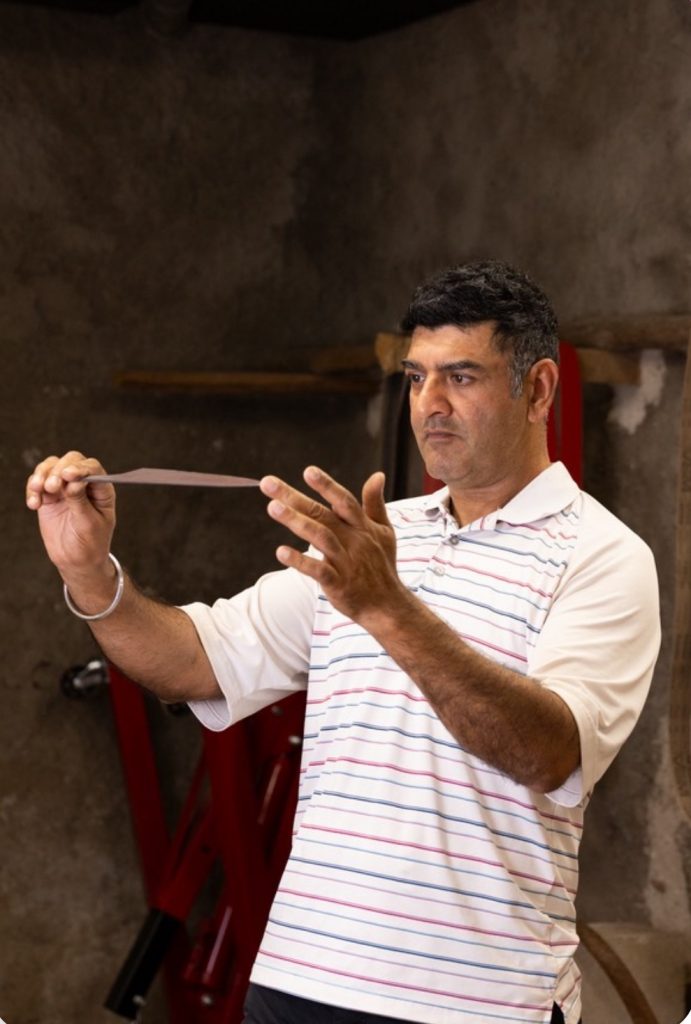
photo credit: Morgane Duchateau
To start off, please tell us a little about yourself.
I am Harbeer Chahal, American living in the south of France near Spain. I was born in London and hold 3 nationalities, UK/Canada/USA. I have lived in France for 3 1/2 years, previously living in central Arizona and the most of my life in Los Angeles. I am married to a French woman who is an actress. My career background is in manufacturing operations and engineering management. I have an executive MBA from Loyola Marymount and an MPP from University of Southern California.
On a personal note, I like to get out play golf, travel, and explore new areas with my wife. This summer I will work on getting a motorcycle license here in France and ride a little bit. I enjoy trying new restaurants as I am a gourmand (foodie), I like cortados in Spain.
What sparked your interest in knives?
I started my journey as a collector of custom folding knives. I collected and bought and sold many folding knives.
What inspired you to do this and how did you learn?
I was inspired by the idea of independence and freedom. The idea that I could work the way I wanted to, when I wanted to, and with whom I wanted to. At first, I tried to learn on my own, but I found that inefficient. So, then I sought out classes from other known makers, I traveled the country learning from them. I prefer to learn in person directly from someone, I would like to see more apprentice opportunities with knife makers.
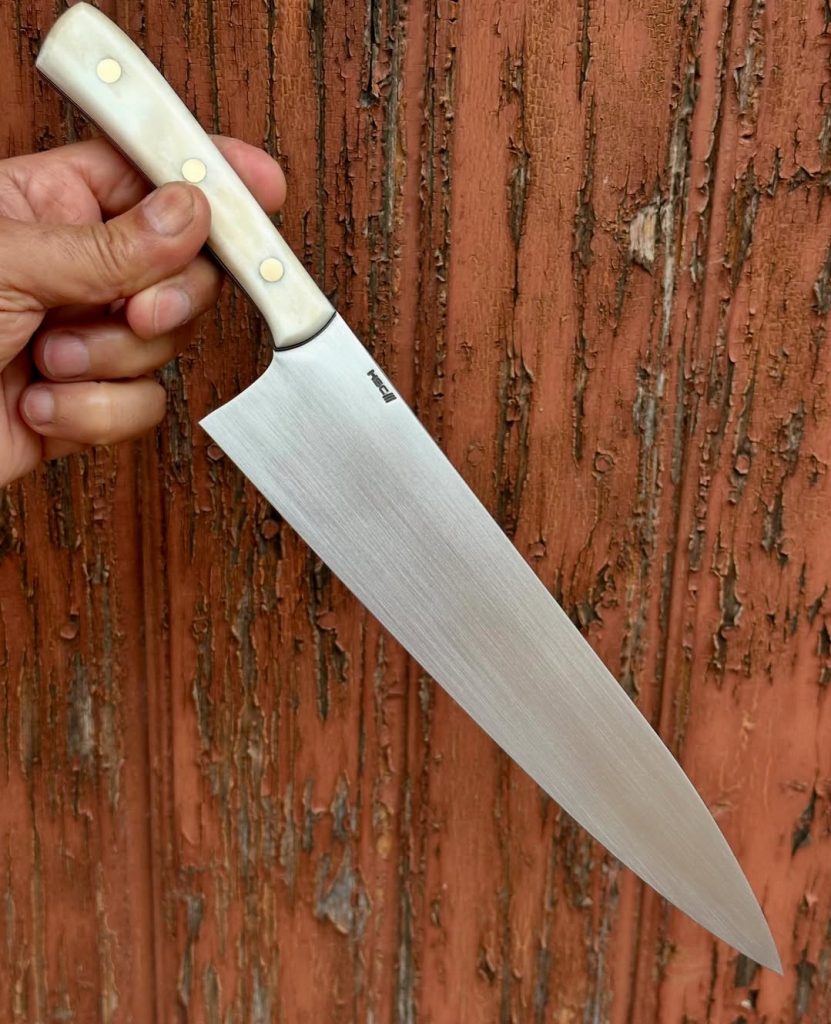
When did you start making knives?
I started making knives in 2015/16 when I first bought a variable speed grinder. I received a nice Christmas bonus from my then employer and decided to give it a go. I went full-time as a maker in early 2018.
What did you make your first knife with?
I actually do not recall the very first knife I made. But I know they were not very good…but everyone as to start somehow. If I had to guess, I believe I used AEB-L stainless steel that I sent out for heat treating. It was a stock removal outdoor style knife.
Do you have a favorite knife you made, tell me about it?
I don’t have a favorite that sticks out in my mind; however, I really like the Apex Ultra/wrought iron clad kitchen knives I made. I obtained the cladding from a vintage wine barrel strap I got from an ancient local winery here in the south of France. I also like a stag handled slip joint I made a few years ago.
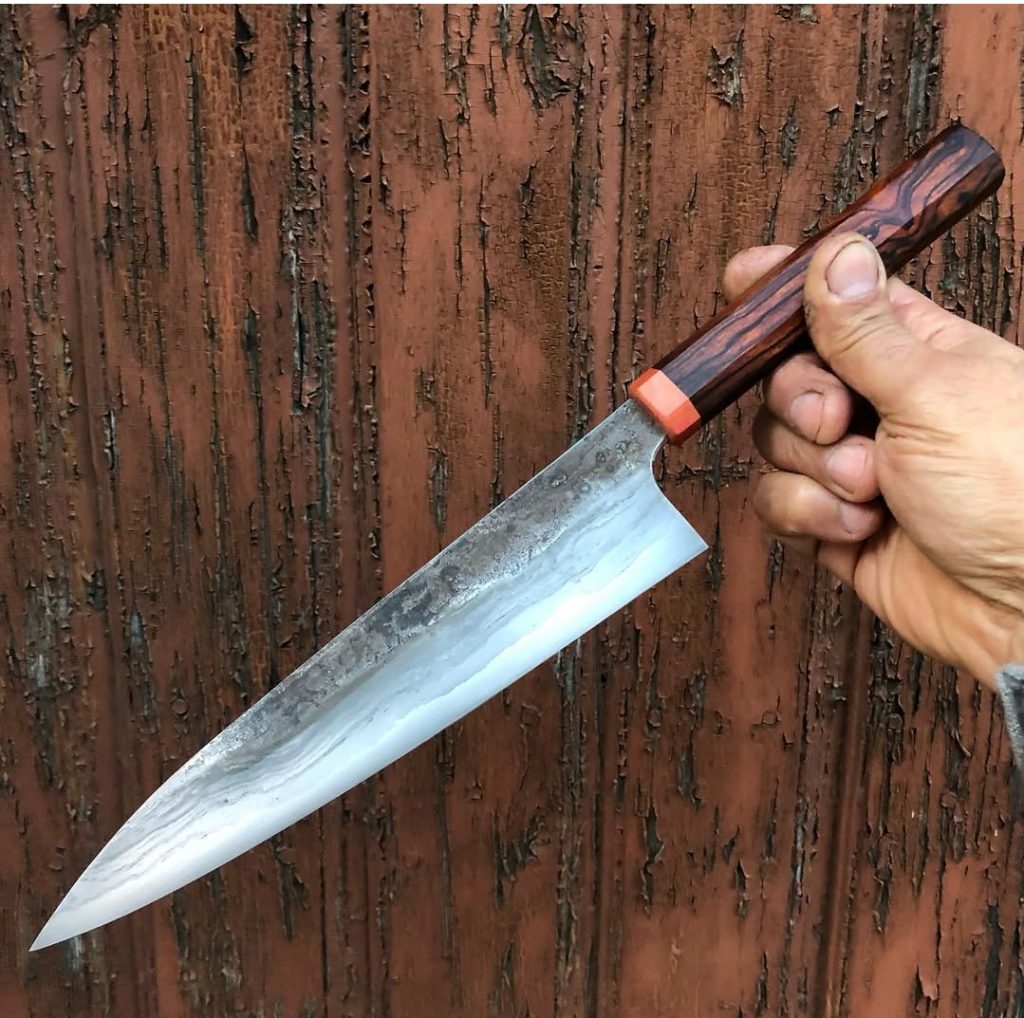
What is the most important aspect of a well-made knife?
I would have to say the bevel geometry. Without the right geometry, the knife simply won’t cut well and be pleasant to use. But in broader terms the well-made knife should fit the task at hand.
What keeps you going?
Well, we all need money… and the desire to stay independent. The money and independence allow me to play more golf.
Biggest struggle?
I would say my story telling and promotion of myself is weak and needs improvement. When you work as an artisan/craftsman, you need either your own niche, or it’s helpful to speak your story well to your audience.
What kinds of knives do you make?
I make kitchen knives, mostly to order. Occasionally I make slip joint folders, which are difficult to do at high level when you are not doing them all the time. I can also make Carter style outdoor utility neck knives which I like a lot.
Why the focus on kitchen knives?
Early on in my journey I didn’t like making knives that were just collected such as a slipjoint. Even though I used to be a collector myself. Kitchen knives are used regularly, daily, sometimes all day. They have to work and work well. The heat treatment is thus tested and proven regularly. The grind, ergonomics, edge profile and sharpness all have to be there. Lastly, cooking is part of the human experience, and I take great pride in knowing my knives are used around the world on a regular basis, by professionals, chefs, and home users.
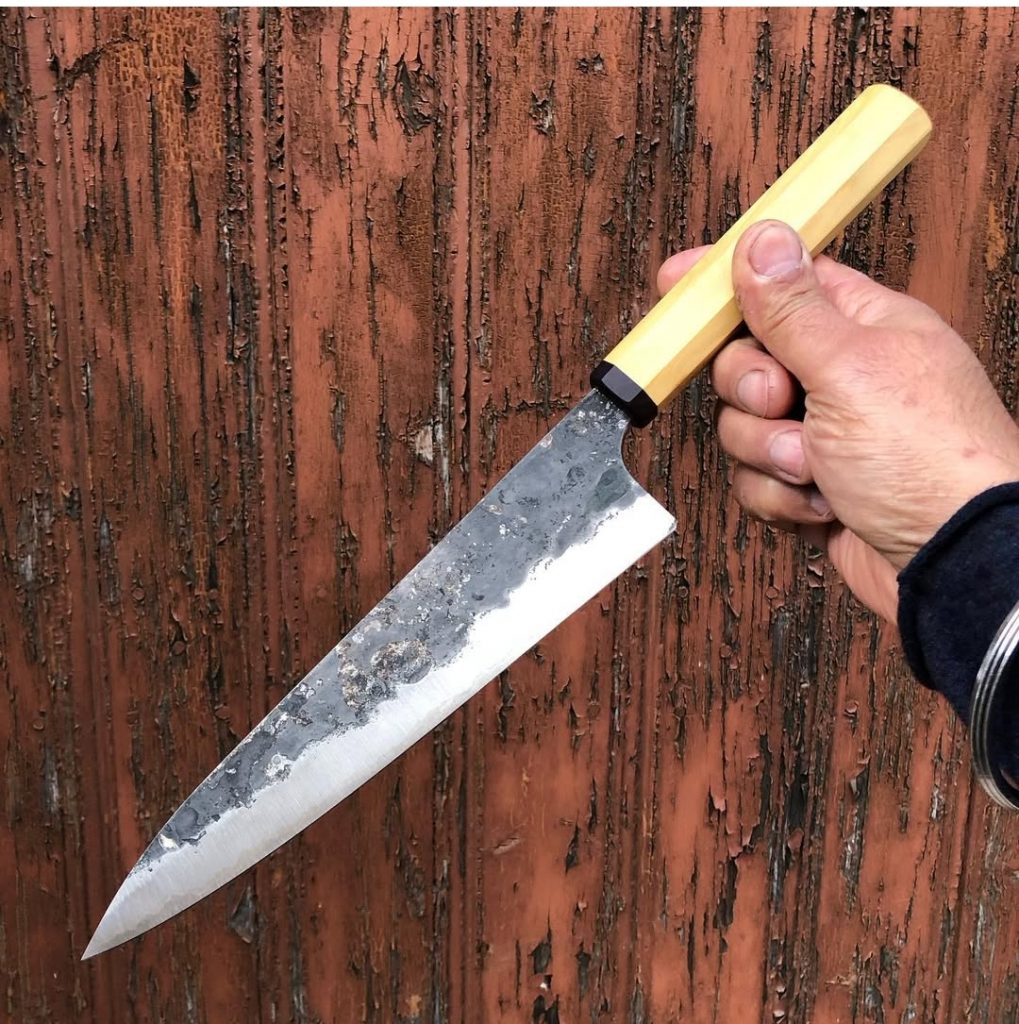
How did your background affect your approach to knives?
Despite my background in manufacturing and engineering, I have little desire to utilize automation or highly technical skills in my knifemaking. I prefer more handwork and one off making. Although I do invest in quality machines and tools. You never regret overbuying on equipment or tooling.
Who helped you early on?
Mike Vagnino ABS MS (American Bladesmithing Society – Master Smith) gave me first grinding lesson, he also helped guide my early work with honest criticism. Mike also taught me friction folders and then slip joint folders. Murray Carter ABS MS who taught me bladesmithing with Japanese laminated steels. Tim Wright of Sedona AZ helped me with heat treating high alloy steels and thinking about “flow” in design.
Who are your influences?
I would say primarily Murray Carter. He is incredibly skilled.
What other knife makers out there impress you these days? Do you take inspiration from anyone else in the field?
I actually don’t pay a lot of attention to other knife makers work, but I am inspired by Murray Carter’s knives and lock back folders from Tim Wright. Knifemakers who don’t produce a lot and who do a lot of intricate handwork, I have a big appreciation of.
Any specific breakthroughs or revelations in your knife making journey?
Another knifemaker once said that knife making is primarily about solving problems. Another told me that for the difficult work, to learn to enjoy the process. These 2 thoughts are breakthroughs for me in my thinking of how to work.
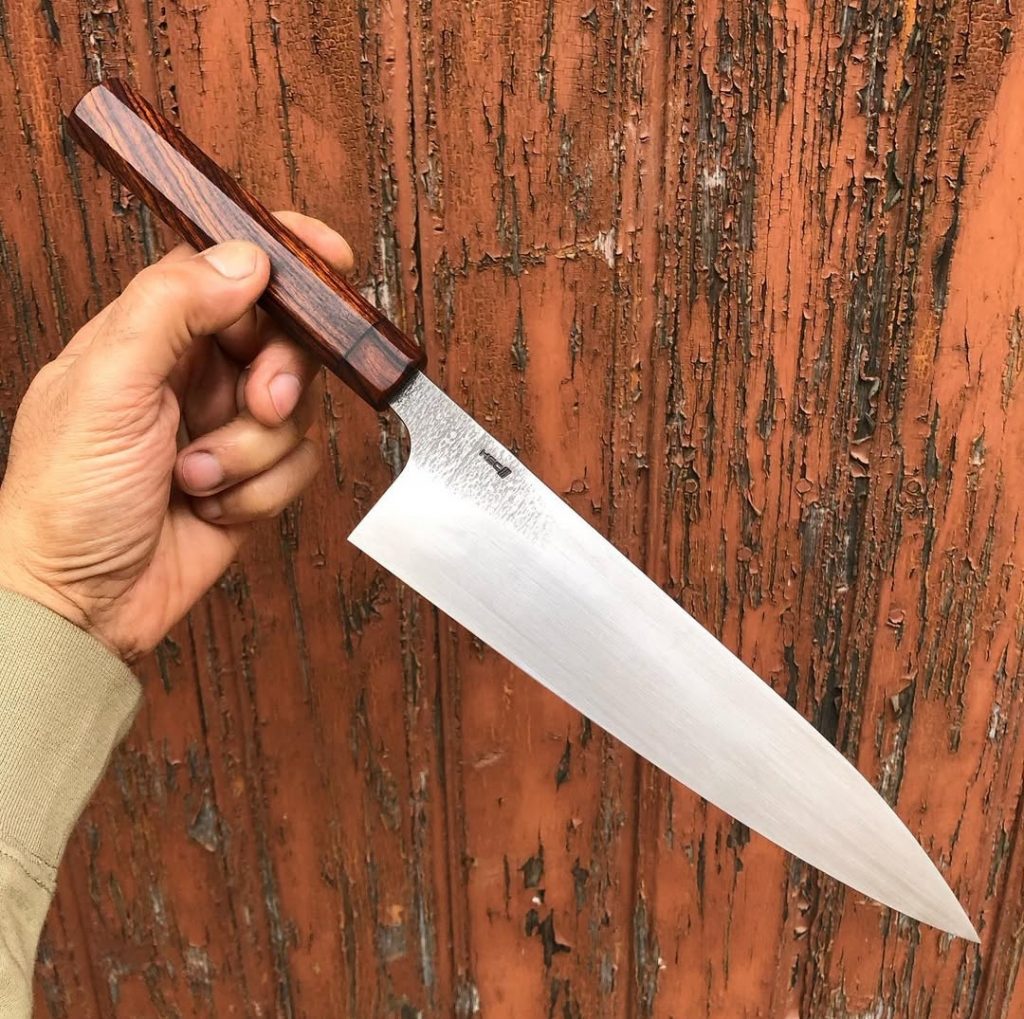
What is the perfect knife?
The perfect knife is the one you love to carry, the one you love to use, the one that speaks to you, the one that works well for your needs, the one that gives some pleasure.
How do you approach knife testing?
At my stage of skill and experience I don’t have the same need for testing per se, as I did in my early knife making stage. Early on I relied on sophisticated users, chefs and collectors to give me feedback on my work. I also provided my work to pass arounds where several interested participants publish their feedback online.
How do you develop a design, select a steel, and fine-tune a heat treatment?
I make humble straightforward knives that work very well so I have standard design shapes that vary slightly. Only recently have I settled on a 240 mm gyuto profile that I would call my standard offering. The market interest drives some of my steel selection as I do work on custom orders regularly. I enjoy forging and working with laminated steels with high carbon cores, but I can’t ignore the performance capabilities of high alloy steels such as CPM Cru Wear which I have been using since 2019. With heat treatment I don’t chase the highest hardness range of a steel unless a customer requests it.
What is your favorite steel, and what do you like about it?
I really like CPM CruWear steel. For kitchen knives (and perhaps most other style) I think it is the perfect blend of sharpness, toughness, and edge retention, as well as being reasonably carefree in practical use. It is difficult to grind and even more difficult to finish, it’s time consuming. It’s not the sexiest steel as compared to say laminated steels with wrought iron cladding, but it has many other advantages. If you want a no-nonsense steel that works exceptionally well, CruWear should be the one.
How has the knife world changed since you started?
The barriers to entry for knife making are low, so almost anyone can enter the field. Also, there is an abundance of tutorials online that allow most anyone to learn online at practically little cost to themselves. So there seems to be many new entries into knife making adding to the innovations and desires to differentiate oneself. Additionally, there seems to be an abundance of knife making supply companies so more availability of equipment and supplies as well as new tools.
What’s up next for you? Any exciting new projects to tell us about?
Nothing specific at this time, although I would like to get back to making some more complex frame handles. I used to do this with stag and a bronze frame. These require some accurate fitting and execution. I also want to work with stingray leather that I picked up in Dallas. At one time I did want to produce and test for a JS (journeysmith) rating with the ABS, but my membership lapsed and so I would have to rejoin the ABS and wait 3 years. I also want to make leather sheath protectors for the kitchen knives. I did take a short class in Dallas, but I need to invest myself into the process to be good at it.
To see more of Harbeer’s work head to his website https://www.hsc3knives.com/ or his Instagram https://www.instagram.com/hsc3.knives/
One response to “HSC /// Knives”
-
This was a thoughtful and engaging interview with Harbeer, and I enjoyed reading about his journey from collector to knife maker. With his background and multiple masters degrees, it’s surprising and impressive that he transitioned into hands-on craftsmanship, but I guess that’s what life is about. I also like that he values practicality and usability over hype. But as an owner of one of his wrought clad knives, I can say that he is also very capable of making a sexy looking knife that cuts superbly.
Leave a Reply to Rich Cancel reply